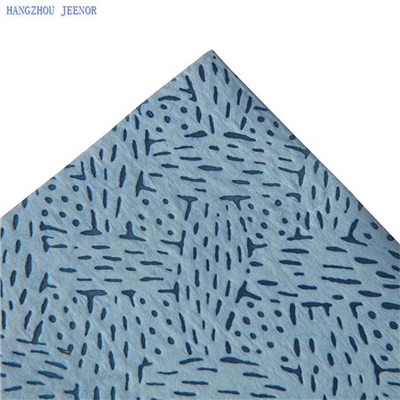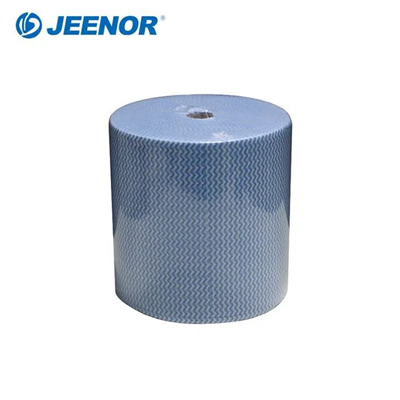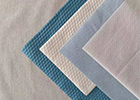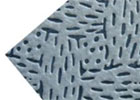Diving into the Impressive Filter Performance of Meltblown Spunlace Nonwovens
Understanding Meltblown Spunlace Nonwovens
Meltblown spunlace nonwovens are a type of nonwoven material that exhibit impressive filter performance. These nonwovens are created by combining the meltblown and spunlace processes, resulting in a fabric with unique properties.
The composition and structure of meltblown spunlace nonwovens play a crucial role in their filtration capabilities. They are typically made from synthetic fibers such as polypropylene, which provide strength and durability. The combination of the meltblown process, which creates fine fibers, and the spunlace process, which entangles these fibers together, results in a fabric with a high surface area and excellent filtration efficiency.
The significance of filter performance in nonwovens cannot be overstated. Nonwoven filters are widely used in various industries to remove contaminants from air or liquids. The efficiency of these filters is determined by factors such as pore size distribution, particle retention capacity, and pressure drop.
Meltblown spunlace nonwovens excel in their filtration capabilities due to their small fiber diameter and uniform pore size distribution. They can efficiently capture particles of different sizes while maintaining low pressure drop across the filter.
These exceptional filter properties make meltblown spunlace nonwovens suitable for applications in air filtration systems and liquid filtration processes. They provide effective removal of airborne pollutants, dust particles, bacteria, and other contaminants.
Compared to traditional filtration materials like woven fabrics or paper filters, meltblown spunlace nonwovens offer several advantages. They have higher filtration efficiency, greater durability, resistance to moisture damage, and can be customized for specific applications.
In conclusion, understanding the impressive filter performance of meltblown spunlace nonwovens is essential for realizing their potential applications across various industries. With ongoing advancements in technology and research efforts focused on improving filter performance even further, these materials hold promise for future developments in the field of nonwoven filter technology.
Overview of Meltblown Spunlace Nonwovens
Meltblown spunlace nonwovens are a type of nonwoven material that combines the meltblown and spunlace processes to create a fabric with exceptional filter performance. These nonwovens are made from synthetic fibers, such as polypropylene, which provide strength and durability.
The combination of the meltblown process, which creates fine fibers, and the spunlace process, which entangles these fibers together, results in a fabric with a high surface area and excellent filtration efficiency. Meltblown spunlace nonwovens excel in capturing particles of different sizes while maintaining low pressure drop across the filter.
These unique properties make them suitable for various applications in air filtration systems and liquid filtration processes. They effectively remove airborne pollutants, dust particles, bacteria, and other contaminants.
Compared to traditional filtration materials like woven fabrics or paper filters, meltblown spunlace nonwovens offer higher filtration efficiency, greater durability, resistance to moisture damage, and can be customized for specific applications. With ongoing advancements in technology and research efforts focused on improving filter performance even further, these materials hold promise for future developments in the field of nonwoven filter technology.
Composition and Structure of Meltblown Spunlace Nonwovens
Meltblown spunlace nonwovens are composed of synthetic fibers, typically polypropylene, that provide strength and durability to the fabric. The unique structure of these nonwovens is achieved through a combination of the meltblown and spunlace processes.
In the meltblown process, thermoplastic polymer pellets are melted and extruded through tiny nozzles to form microfibers. These microfibers are then rapidly cooled and collected on a conveyor belt or drum, creating a web-like structure.
The spunlace process involves entangling the meltblown fibers with high-pressure water jets. This entanglement gives the fabric its strength and stability.
The resulting nonwoven material has a random fiber orientation and a high surface area due to the fine fibers created in the meltblown process. This high surface area enhances its filtration capabilities by effectively capturing particles of varying sizes.
Overall, the composition and structure of meltblown spunlace nonwovens contribute to their exceptional filter performance and make them suitable for various filtration applications.

Importance of Filter Performance in Nonwovens
Filter performance plays a crucial role in the effectiveness of nonwoven materials for filtration applications. Nonwovens are widely used in industries such as healthcare, automotive, and environmental protection to remove contaminants and particles from fluids or air. The quality of the filter directly impacts its ability to capture and retain particles of various sizes.
Efficient filter performance ensures cleaner air, purer water, and improved product quality. It also helps maintain equipment functionality by preventing clogging or damage caused by particulate matter. Additionally, effective filtration is essential for maintaining a safe and healthy environment for workers and the general public.
Factors such as pore size distribution, particle retention capacity, pressure drop resistance, and filtration efficiency determine the filter's overall performance. Improving these characteristics enhances the filter's capabilities in removing contaminants effectively.
Given the importance of filtration in numerous industries, developing nonwoven materials with enhanced filter performance is crucial for meeting stringent regulatory requirements and achieving optimal results in various applications.
Significance of Filter Performance
Filter performance is of utmost importance in nonwoven materials for filtration applications. It directly affects the efficiency and effectiveness of removing contaminants and particles from fluids or air. A high-quality filter ensures cleaner air, purer water, and improved product quality. It also prevents clogging or damage to equipment caused by particulate matter, thereby maintaining functionality.
Furthermore, effective filtration plays a crucial role in creating a safe and healthy environment for workers and the general public. By capturing and retaining particles of various sizes, filters help reduce the risk of respiratory issues and airborne diseases.
To achieve optimal filter performance, several factors must be considered, including pore size distribution, particle retention capacity, pressure drop resistance, and filtration efficiency. Improving these characteristics enhances the filter's ability to remove contaminants effectively.
Overall, the significance of filter performance cannot be overstated as it ensures reliable filtration across various industries while meeting regulatory requirements for clean environments and sustainable practices.
Factors Affecting Filter Performance in Nonwovens
Several factors play a crucial role in determining the filter performance of nonwoven materials. These factors directly impact the efficiency and effectiveness of filtration processes.
- Pore Size Distribution: The distribution of pore sizes in a nonwoven material affects its ability to capture particles of different sizes. A narrow and uniform pore size distribution ensures better particle retention.
- Particle Retention Capacity: The filter's ability to retain particles depends on its pore structure and surface properties. Nonwovens with high particle retention capacity can effectively trap contaminants and prevent their release into the filtered fluid or air.
- Pressure Drop Resistance: Filters should maintain low pressure drop while filtering fluids or air to ensure efficient flow rates. Higher pressure drops can lead to reduced filtration performance and increased energy consumption.
- Filtration Efficiency: The overall efficiency of a filter is determined by its ability to remove contaminants from fluids or air. High filtration efficiency ensures cleaner outcomes and reduces the risk of contamination.
By considering these factors, manufacturers can optimize filter performance in nonwovens for various applications, ensuring effective removal of particulate matter while maintaining operational efficiency.

Enhanced Filtration Capabilities of Meltblown Spunlace Nonwovens
Meltblown spunlace nonwovens offer enhanced filtration capabilities, making them highly effective in various applications. These nonwoven materials exhibit exceptional filtration efficiency, allowing for the removal of a wide range of particulate matter.
The efficiency of meltblown spunlace nonwovens filters is attributed to their unique composition and structure. The fine fibers and interconnected network create a dense matrix that efficiently traps and retains particles. Additionally, the narrow and uniform pore size distribution ensures effective particle retention across different sizes.
Furthermore, meltblown spunlace nonwovens have high particle retention capacity due to their surface properties. The fibers' electrostatic charge attracts particles, preventing their release back into the filtered fluid or air.
These impressive filtration capabilities make meltblown spunlace nonwovens suitable for various applications. They are commonly used in air filtration systems to remove pollutants and allergens from indoor environments. Additionally, they are utilized in liquid filtration processes to purify water and separate solids from liquids.
Overall, the enhanced filtration capabilities of meltblown spunlace nonwovens contribute to cleaner outcomes and improved quality in a wide range of industries.
Efficiency of Meltblown Spunlace Nonwovens Filters
The efficiency of meltblown spunlace nonwovens filters is a key factor in their impressive performance. These filters are highly efficient at trapping and retaining particulate matter, making them ideal for various applications.
The fine fibers and interconnected network of meltblown spunlace nonwovens create a dense matrix that effectively captures particles. Additionally, the narrow and uniform pore size distribution ensures that particles of different sizes are efficiently retained.
Furthermore, the surface properties of these nonwoven filters contribute to their high particle retention capacity. The electrostatic charge present on the fibers attracts particles, preventing them from being released back into the filtered fluid or air.
Overall, the efficiency of meltblown spunlace nonwovens filters makes them highly effective in achieving cleaner outcomes and improved quality in industries such as air filtration systems and liquid filtration processes.
Particle Retention and Pore Size Distribution
Particle retention and pore size distribution are critical factors that contribute to the efficient filtration capabilities of meltblown spunlace nonwovens filters. The fine fibers and interconnected network of these filters create a dense matrix that effectively traps and retains particles. The narrow and uniform pore size distribution ensures that particles of different sizes are efficiently captured.
The ability to retain particles is further enhanced by the electrostatic charge present on the fibers. This charge attracts and holds onto particles, preventing them from being released back into the filtered fluid or air.
The particle retention capacity and pore size distribution of meltblown spunlace nonwovens filters can be tailored to specific filtration requirements by adjusting process parameters such as fiber diameter, web formation, and bonding techniques. This flexibility allows for customization based on the desired application and target particle size range.
Overall, the combination of particle retention capability, uniform pore size distribution, and customizable design make meltblown spunlace nonwovens filters highly effective in achieving superior filtration performance in various industries.

Applications of Meltblown Spunlace Nonwovens in Filtration
Meltblown spunlace nonwovens have a wide range of applications in filtration systems. They are commonly used in air filtration applications, such as HVAC filters and face masks, where they effectively capture airborne particles and improve indoor air quality. The fine fibers and uniform pore size distribution of meltblown spunlace nonwovens allow for efficient particle retention.
In liquid filtration processes, these nonwovens are utilized in various industries, including pharmaceuticals, food and beverage, and wastewater treatment. They can effectively remove contaminants from liquids while maintaining high flow rates.
The versatility of meltblown spunlace nonwovens also extends to other areas such as automotive filters, oil filtration, and industrial dust collection systems.
Compared to traditional filtration materials like paper or woven fabrics, meltblown spunlace nonwovens offer several advantages. They provide higher efficiency in particle capture due to their finer fibers and greater surface area. Additionally, these nonwovens can be produced with a lower pressure drop, reducing energy consumption in the filtration process.
Overall, the exceptional performance of meltblown spunlace nonwovens makes them indispensable across various filtration applications.
Utilization in Air Filtration Systems
Meltblown spunlace nonwovens play a crucial role in air filtration systems, where their exceptional performance is highly valued. These nonwovens are extensively used in HVAC filters and face masks to improve indoor air quality by effectively capturing airborne particles.
The fine fibers and uniform pore size distribution of meltblown spunlace nonwovens allow for efficient particle retention, ensuring that even the smallest contaminants are trapped. This makes them ideal for filtering out dust, pollen, mold spores, bacteria, and other harmful particles.
In addition to their high filtration efficiency, meltblown spunlace nonwovens offer advantages such as low pressure drop and high airflow rates. This means that air can pass through the filter easily without compromising its effectiveness.
Overall, the utilization of meltblown spunlace nonwovens in air filtration systems helps create a healthier and cleaner environment by removing pollutants from the air we breathe. Their ability to efficiently capture particles makes them indispensable in maintaining optimum indoor air quality.
Role in Liquid Filtration Processes
Meltblown spunlace nonwovens also play a vital role in liquid filtration processes. Their unique structure and properties make them highly effective in removing particles, contaminants, and impurities from liquids.
These nonwoven materials are widely used in applications such as water treatment, industrial filtration, and food processing. They are capable of capturing suspended solids, sediments, oils, and other unwanted substances present in liquids.
The exceptional filtration capabilities of meltblown spunlace nonwovens can be attributed to their fine fibers and porous structure. The fibers create a dense network that efficiently traps particles while allowing the liquid to pass through.
Moreover, these nonwovens offer excellent chemical resistance and durability, ensuring long-lasting performance in demanding liquid filtration applications.
Overall, meltblown spunlace nonwovens are essential components in liquid filtration systems for maintaining clean and purified fluids across various industries.

Comparison with Traditional Filtration Materials
Meltblown spunlace nonwovens offer several advantages over traditional filtration materials. Firstly, their fine fibers and porous structure provide a higher filtration efficiency, allowing for the removal of smaller particles. This results in cleaner air or liquid output.
Compared to materials like paper or woven fabrics, meltblown spunlace nonwovens have a more uniform pore size distribution, which ensures consistent filtration performance. Additionally, these nonwovens are highly durable and resistant to chemicals, making them suitable for harsh environments.
In terms of cost-effectiveness, meltblown spunlace nonwovens often outperform traditional materials due to their efficient particle retention capabilities and longer lifespan. They require less frequent replacement or maintenance compared to other filtration media.
Overall, the exceptional filter performance of meltblown spunlace nonwovens makes them a superior choice for various applications. Their advanced features and cost-efficiency contribute to their growing popularity in the filtration industry.
Advantages of Meltblown Spunlace Nonwovens Filters
Meltblown spunlace nonwovens filters offer several advantages over traditional filtration materials. Firstly, their fine fibers and porous structure provide a higher filtration efficiency, allowing for the removal of smaller particles. This results in cleaner air or liquid output.
Compared to materials like paper or woven fabrics, meltblown spunlace nonwovens have a more uniform pore size distribution, which ensures consistent filtration performance. Additionally, these nonwovens are highly durable and resistant to chemicals, making them suitable for harsh environments.
In terms of cost-effectiveness, meltblown spunlace nonwovens often outperform traditional materials due to their efficient particle retention capabilities and longer lifespan. They require less frequent replacement or maintenance compared to other filtration media.
Overall, the exceptional filter performance of meltblown spunlace nonwovens makes them a superior choice for various applications. Their advanced features and cost-efficiency contribute to their growing popularity in the filtration industry.
Differences in Performance and Durability
Meltblown spunlace nonwovens filters exhibit distinct differences in performance and durability compared to traditional filtration materials. One key advantage lies in their superior filtration efficiency, which stems from the fine fibers and porous structure of these nonwovens. This allows them to effectively capture smaller particles, resulting in cleaner air or liquid output.
Additionally, meltblown spunlace nonwovens offer a more uniform pore size distribution, ensuring consistent filtration performance. Their robust construction and resistance to chemicals make them highly durable even in harsh environments.
In contrast, traditional materials such as paper or woven fabrics often lack the same level of filtration precision and durability. They may not be able to efficiently remove small particles or withstand challenging conditions for prolonged periods.
Overall, the exceptional filter performance and durability of meltblown spunlace nonwovens position them as a superior choice over traditional materials for various applications.

Conclusion and Future Prospects
In conclusion, meltblown spunlace nonwovens demonstrate impressive filter performance and durability compared to traditional filtration materials. Their fine fibers and porous structure contribute to superior filtration efficiency, allowing them to effectively capture smaller particles. The uniform pore size distribution ensures consistent filtration performance, while their robust construction and resistance to chemicals make them highly durable even in challenging environments.
Looking ahead, there are promising prospects for the future of meltblown spunlace nonwovens in the field of filtration. Ongoing research and development efforts are focused on further enhancing their filter performance, expanding their applications across different industries, and exploring new methods of production that can improve efficiency and reduce costs.
With their exceptional filtration capabilities, meltblown spunlace nonwovens have the potential to revolutionize various sectors such as air and liquid filtration systems. As advancements continue, we can expect to see even more innovative solutions utilizing these high-performance materials in the future.
Summary of Filter Performance in Meltblown Spunlace Nonwovens
Meltblown spunlace nonwovens exhibit impressive filter performance due to their fine fibers and porous structure. These materials offer high filtration efficiency, effectively capturing smaller particles. The uniform pore size distribution ensures consistent filtration performance. Additionally, the robust construction and chemical resistance of meltblown spunlace nonwovens contribute to their durability in challenging environments.
In comparison to traditional filtration materials, meltblown spunlace nonwovens have several advantages. They provide superior filtration capabilities and are highly efficient in removing contaminants from both air and liquid streams. Moreover, these materials offer longer service life and increased resistance to clogging.
Looking ahead, there is a promising future for meltblown spunlace nonwovens in the field of filtration. Ongoing research aims to enhance their filter performance even further, expand their applications across industries, and explore cost-effective production methods. With their exceptional capabilities, these high-performance materials have the potential to revolutionize various sectors reliant on effective filtration systems.
Potential Developments in Nonwoven Filter Technology
As research in nonwoven filter technology continues to advance, there are exciting possibilities for further developments in the field. Scientists and engineers are exploring ways to enhance the filtration performance of meltblown spunlace nonwovens even further.
One area of focus is improving the efficiency of these filters by optimizing their pore size distribution and fine-tuning the fiber composition. By understanding how different materials and manufacturing techniques affect filtration performance, researchers can develop filters that offer even higher levels of particle retention and improved overall efficiency.
Another avenue being explored is expanding the applications of meltblown spunlace nonwovens in various industries. These high-performance filters have already shown great potential in air and liquid filtration systems, but ongoing research seeks to identify new uses for them. From healthcare to automotive, there are countless opportunities to leverage the exceptional capabilities of these materials.
Moreover, efforts are being made to explore cost-effective production methods that can increase accessibility and affordability without compromising on filter performance.
Overall, with continuous advancements in nonwoven filter technology, we can expect significant improvements in filter performance, expanded application areas, and more cost-effective solutions in the future.





















